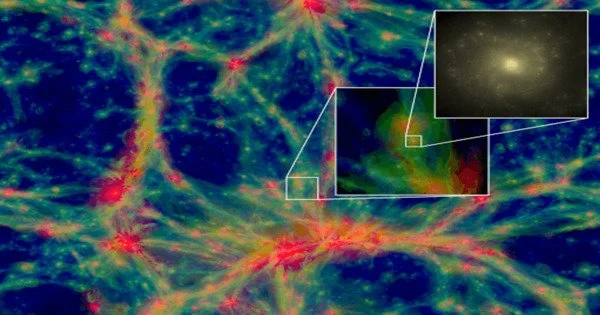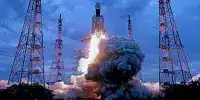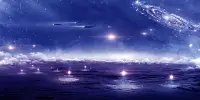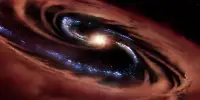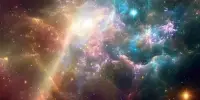For the past two decades, physicists have known that the universe’s expansion is accelerating, as if some strange “dark energy” is blowing up space like a balloon. In fact, cosmologists’ well-tested standard model assumes that dark energy accounts for 69 percent of the universe’s content. According to a group of theorists, there may be no need for the mysterious stuff. Instead, the researchers contend that the universe’s acceleration could be caused by variations in density, or inhomogeneities. If this is the case, one of physics’ most perplexing mysteries could be explained using nothing more than Albert Einstein’s well-known general theory of relativity.
Scientists present the first simulation of neutron star collisions in cosmological extensions of general relativity, offering a new approach to testing gravity. With Einstein’s theory, a massive amount of mysterious dark energy is required to explain cosmological phenomena such as the accelerated expansion of the Universe. But what if dark energy is an illusion, and general relativity must be altered?
A new SISSA study published in Physical Review Letters takes a fresh look at the question. Scientists produced the first simulation ever of merging binary neutron stars in theories beyond general relativity that reproduce a dark-energy-like behavior on cosmological scales, thanks to the massive computational and mathematical effort. This allows for a comparison of Einstein’s theory and modified versions of it, and with sufficiently accurate data, it may be possible to solve the mystery of dark energy.
Neutron stars are the densest stars that exist, typically only 10 kilometers in radius, but with a mass between one or two times the mass of our Sun. This makes gravity and the spacetime around them extreme, allowing for abundant production of gravitational waves when two of them collide.
Enrico Barausse
For about 100 years now, general relativity has been very successful at describing gravity on a variety of regimes, passing all experimental tests on Earth and the solar system. However, to explain cosmological observations such as the observed accelerated expansion of the Universe, we need to introduce dark components, such as dark matter and dark energy, which still remain a mystery.
Enrico Barausse, astrophysicist at SISSA (Scuola Internazionale Superiore di Studi Avanzati) and principal investigator of the ERC grant GRAMS (GRavity from Astrophysical to Microscopic Scales), wonders if dark energy exists or if it is a breakdown in our understanding of gravity. “The existence of dark energy may be an illusion,” he says, adding that “the accelerated expansion of the Universe may be caused by some yet unknown modifications of general relativity, a kind of ‘dark gravity’.”
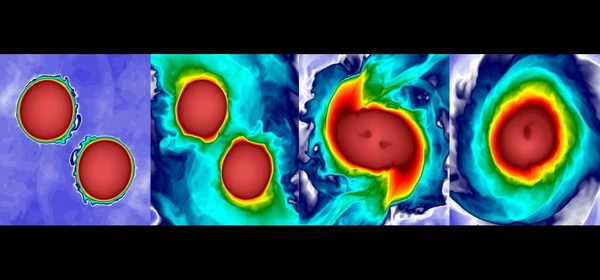
The merger of neutron stars offers a unique situation to test this hypothesis because gravity around them is pushed to the extreme. “Neutron stars are the densest stars that exist, typically only 10 kilometers in radius, but with a mass between one or two times the mass of our Sun,” explains the scientist. “This makes gravity and the spacetime around them extreme, allowing for abundant production of gravitational waves when two of them collide. We can use the data acquired during such events to study the workings of gravity and test Einstein’s theory in a new window.”
In this study, published in Physical Review Letters, SISSA scientists worked with physicists from Universitat de les Illes Balears in Palma de Mallorca to create the first simulation of merging binary neutron stars in cosmologically relevant modified gravity theories: “Because of the highly non-linear nature of the problem, this type of simulation is extremely difficult,” explains Miguel Bezares, the paper’s first author. It necessitates a massive computational effort – months of running on supercomputers – which was made possible by an agreement between SISSA and the CINECA consortium, as well as novel mathematical formulations developed by us. For many years, these were major roadblocks until our first simulation.”
Researchers can now compare general relativity and modified gravity thanks to these simulations. “Surprisingly, we discovered that the ‘dark gravity’ hypothesis is just as good as general relativity at explaining data from past binary neutron star collisions as the LIGO and Virgo interferometers. The differences between the two theories in these systems are indeed subtle, but they may be detectable by next-generation gravitational interferometers like the Einstein telescope in Europe and Cosmic Explorer in the United States. This opens up the intriguing prospect of using gravitational waves to distinguish between dark energy and ‘dark gravity.’ “Barausse then concludes.
